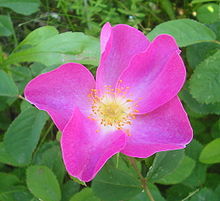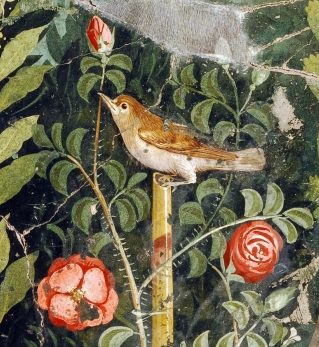
Rosa gallica is probably the oldest rose in existence. Native to southern and central Europe, it was first domesticated by the ancient Greeks and Romans and most modern roses can trace their ancestry back to it. The ancient Roman naturalist, Pliny the Elder (d. 79 AD), identifies 12 kinds of roses, 2 of which may be R. gallica. A striped variety of this rose, R. gallica var versicolor, is illustrated in wall paintings from houses in Pompeii. This variety was thought to have originated in the 12 century AD and named Rosa mundi in honor of the mistress of French king, Henry II, but the examples from Pompeii prove this idea incorrect. The Romans highly valued roses and used them in many ways such as making perfume, medicine, and garlands. Photo Credit Wikipedia
Description: The gallic rose is a small thicket forming plant up to 1.6′ tall and has straight slender prickles and pinnately compound leaves with three to seven bluish-green leaflets. The fragrant pink flowers appear in clusters of 1-4 and each flower has five or more petals. Flowering occurs only once during the season. The globose to ovoid hips are about 1/2″ in diameter and orange to brown. Popular varieties that have been identified in the excavations of ancient Pompeii include R. gallica var. versicolor, and R. gallica var. centrifolia.

Type: Deciduous flowering shrub
Size: 1.6′ H (thicket forming)
Bloom Color: Pink
Bloom Time: Spring
Light: Full sun
Soil: Fertile, consistently moist, well-drained
Hardiness: Zones 5-9
Photo Credit Wikipedia